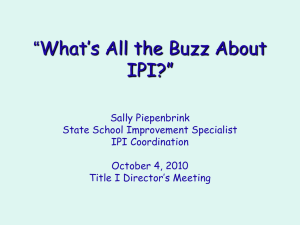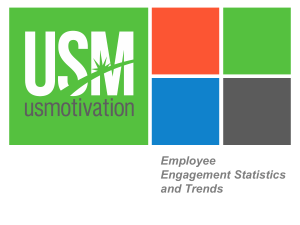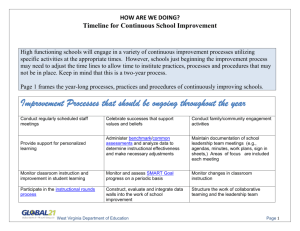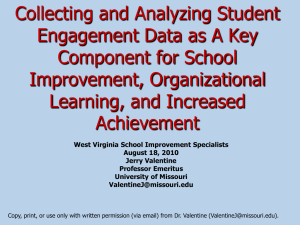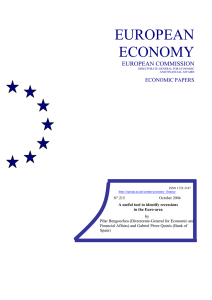Glenna Heinlein State School Improvement Specialist
advertisement
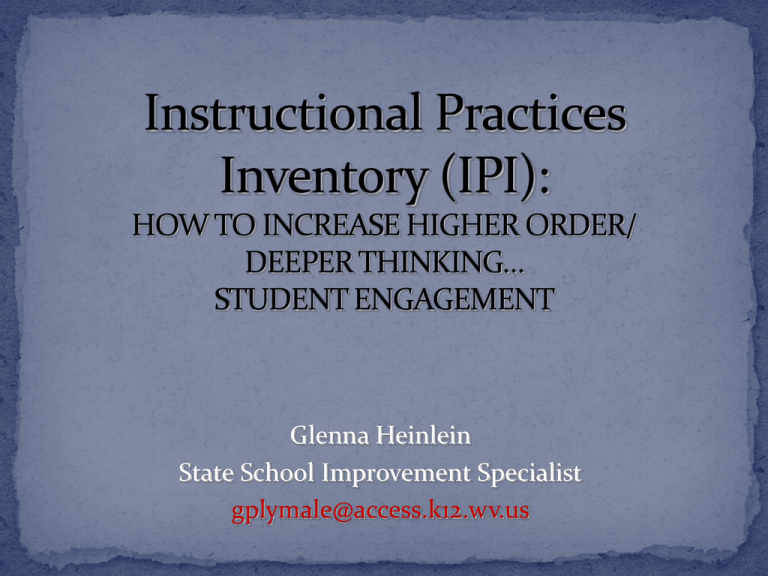
Glenna Heinlein State School Improvement Specialist gplymale@access.k12.wv.us A rigorous and relevant curriculum Teachers with skill and knowledge to deliver the curriculum Students engaged with the curriculum and with their own learning (Bloom, Marzano. John Hattie, Wayne K. Hoy, Good and Brophy, Elmore, etc.) Types……. Social Emotional Physical Cognitive Just because a student is involved (attending to task) does not mean they are cognitively processing, because engagement can be physical, emotional, social, or cognitive. DOK focused on the cognitive process. IPI – Focuses on the students’ involvement in the cognitive process. IPI is a process… .. for gathering data on student engagement (HO/D or not HO/D) .. for using the data as a basis for faculty collaboration and problem solving .. resulting in instructional practice changes ..Developed by Dr. Jerry Valentine to provide an OPTIMUM school wide profile of student engagement that faculty will view as fair and accurate to create a level of comfort to study the data objectively and use the data as the basis for continuous collaborative conversation and problem–solving. It is NOT about teacher evaluation It IS about students engaged with their learning It is NOT a program It IS a process It is NOT about the “activity” in which the students are engaged It IS about “how” the students are engaging in the activity For overall school improvement in teaching and learning To increase student engagement with the curriculum and their own learning To connect IPI categories to DOK levels For school growth… 1. Collect data? 2. Depict data in simple format? 3. Study and reflect about the data? 4. Use the data? A feasible, systematic process for collecting observation data that is fair and accurate. “typical” school day substitutes give notification focus on students who codes majority develop a plan collect large volume of all learning settings snapshot regular learning time data points protect anonymity 2 Mental Images 1. Collect Data 2. Collaborative Conversations with Staff Develop a plan Step into classroom Look at kids Look at work Talk to kids/teacher Step out into hall and code Total Time: Average 1-3 minutes 100-150 Observations per day 1. Collect Data Place teachers randomly in small groups 2. Distribute data profiles 3. Engage in collaborative conversations about data 4. Trigger Questions: a. Typical day? Classroom? b. Celebrations? c. Issues/Concerns? d. What is our plan? 1. 2. Collaborative Conversations with Staff “Descriptions of student engagement” NOT Higher Order OR Not Higher Order LEVELS OR HIERARCHY Analysis is the beginning of Higher Order Recall, Memorization, Simple Process, Simple Understanding, Fact finding, Skill Development, Practice RUBRIC – 6 IPI Categories Student-Engaged Instruction 6 – Student active engaged learning - HO 5 – Student learning conversations – may be teacher stimulated but not teacher dominated – HO ________________________________________ Teacher-Directed Instruction 4 – Teacher-led instruction – Not HO 3 – Students doing seatwork, etc. but teacher assistance/support is evident – Not HO Disengagement 2 – Students doing seatwork, etc. but teacher assistance/support not evident – Not HO 1 – Complete disengagement – students not engaged in learning related to curriculum H 6 ACTIVE LEARNING O N O T HO 5 4 It is about the amount of time spent above and below category 4. 3 PASSIVE LEARNING 2 1 Students can be doing independent work or working together...but no verbal discourse. Common Examples (if HO/D): Inquiry-based approaches such as project and problem-based learning, research and discovery learning Authentic demonstrations Independent metacognition, reflective journaling, and self-assessment Higher-order responses to higher-order questions. Pre 2004: 18-20% Post 2004 13-15% Student(s) to student(s) verbal learning. Common examples (if HO/D): collaborative or cooperative learning Peer tutoring, debate, and questioning Partner research and discovery/exploratory learning Socratic learning Small group or whole class analysis and problem solving, metacognition, or reflective discussions 3-5% Teacher leads the learning experience by disseminating content knowledge and/or directions for learning Common Examples: Teacher-directed Q/A, lecture, explanations Teacher direction giving Teacher demonstrations 30-40% Students doing seatwork, book work, worksheets, or tests with teacher assistance/support/attentiveness evident. Common Examples: (Teacher Engaged) Fact finding Building skill or understanding through practice, seatwork, worksheets, chapter review questions Multi-media 25-30% Students doing seatwork, book work, worksheets, or tests with teacher assistance/support/attentiveness NOT evident. Common Examples: (Teacher Not Engaged) While students are working, teacher is: Out of the room Working at computer Grading papers 5-15% Students are disengaged or involved in something that is non-curricular. Common Examples: Students talking, daydreaming, or otherwise inattentive Students misbehaving Students not doing their assigned work Playing non-curricular games. 3-5% High Ach: 0-1% Low Ach: 8-10+ TYPICAL IPI CATEGORY PERCENTAGES 6 5 4 3 2 1 ------- 13-14% 3-5% 30-40% 25-30% 5-10% 3-5% The IPI is NOT about the activity in which the students are engaged… The IPI is about HOW the students are engaging in the activity! NOT A HIERARCHY 6 5 4 3 2 1 Six distinct categories… ways of classifying how students are engaged Learning increases as engagement increases 3 Step Process 1. Collect data using trained observers 2. Collaborative conversations with staff 3. Repeat the process COLLABORATIVE CONVERSATIONS……. Engaging the Staff 5 4 Brainstorm On topic And Share Stimulus: Facilitators give information to staff 5 Break into small groups for conversations 4 5 Discuss and Share – Whole Group 5 Small groups talking with new information New Stimulus: Facilitators give new information and task Examples: Activities for Faculty Debrief “Lets change it up” Individually write specific instructions (lesson plan) that would change this scenario to H.O./deeper thinking lessons: (1) category 5 (2) category 6 Share and discuss at table Whole group share out one example Each table write a category 3 lesson, sign with table number Post on wall Rotate clockwise to next number and change the instruction to make it a category 5 (even numbers), or category 6 (odd numbers) Share out to whole group Create a group “t” chart Individually , think about and write(left side) specific instructions (lesson plan) on chart that would be a category 3 or 4. Discuss as a group and list the thinking skill used (right side) for each activity/lesson. Post on wall. Gallery walk clock wise-beginning at your chart. Provides us with data about student engagement Generates collaborative faculty reflection and discussion about the data Raises the bar for improving instructional practices Leads to more higher order, active and engaged student learning Encourages purposeful, job embedded professional development Improves student learning and achievement Results of Using the IPI Process More Student Engagement Changed More Teachers Engaged With Data More Instructional Practices Changed and Improved Builds capacity of staff to reflect upon their collective teaching practices and moves the bar of expectations toward more higher order/deeper thinking, active and engaged student learning. Activity… Coding Scenarios As the observer enters the science classroom, the students are listening attentively to the teacher give them directions for the litmus experiment they will begin in a few minutes. Most of the students are making a few notes in their notebooks while the teacher explains the process. Which of the IPI categories should be coded for this example? As the observer enters the science classroom, the students are listening attentively to the teacher give them directions for the litmus experiment they will begin in a few minutes. Most of the students are making a few notes in their notebooks while the teacher explains the process. IPI Code: Category 4—Teacher-Led Instruction As the observer enters the language arts classroom, the students are creating (original) poems. The teacher is moving among the students encouraging them as they work. They have a rubric on their desks that addresses rhyme, meter, imagery, content, emotion, and length. As you read the first few stanzas of some of the poems you are impressed with their depth of thought and emotion. Which of the IPI categories should be coded for this example? As the observer enters the language arts classroom, the students are creating (original) poems. The teacher is moving among the students encouraging them as they work. They have a rubric on their desks that addresses rhyme, meter, imagery, content, emotion, and length. As you read the first few stanzas of some of the poems you are impressed with their depth of thought and emotion. IPI Code: Category 6—Student Active Engaged Learning As the observer enters the 8th grade math classroom the students are seated at their tables completing a textbook assignment. When you look at their work you see they are independently computing practice word problems about the total cost of several consumer items and the amount of change to expect. The teacher is working at her computer creating a test and has her back to the students. Which of the IPI categories should be coded for this example? As the observer enters the 8th grade math classroom the students are seated at their tables completing a textbook assignment. When you look at their work you see they are independently computing word problems about the total cost of several consumer items and the amount of change to expect. The teacher is working at her computer creating a test and has her back to the students. IPI Code: Category 2—Student Work w/o Teacher Involved As the you enter the seventh grade social studies class, the students are watching selected segments of the movies Pearl Harbor and Midway. The teacher is standing by the DVD/VCR player watching the segments with the students. You can tell from the books on the students’ desks that the class is studying WWII. You are in the room about one minute. Which of the IPI categories should be coded for this example? As the you enter the seventh grade social studies class, the students are watching selected segments of the movies Pearl Harbor and Midway. The teacher is standing by the DVD/VCR player watching the segments with the students. You can tell from the books on the students’ desks that the class is studying WWII. You are in the room about one minute. IPI Code: Category 3—Student Work with Teacher Involved As the you enter the eighth grade art classroom, the students are in small groups of four or five students. Each group has a print of a classic painting and the students are discussing the paintings. The discussions are stimulated by two analysis-level questions written on the board. One student in each group is taking notes for the group. As you begin to leave the room two minutes after entering, you hear the teacher say that it is time to explain their group analyses and defend them to the whole class. Which of the IPI categories should be coded for this example? As the you enter the eighth grade art classroom, the students are in small groups of four or five students. Each group has a print of a classic painting and the students are discussing the paintings. The discussions are stimulated by two analysis-level questions written on the board. One student in each group is taking notes for the group. As you begin to leave the room two minutes after entering, you hear the teacher say that it is time to explain their group analyses and defend them to the whole class. IPI Code: Category 5—Student Learning Conversations Categories 3-4-5-6 are each important for Learning throughout a unit and/or lesson Eliminate Disengagement (1) Reduce Teacher Disengagement (2) Reduce Seatwork (2-3) Increase HO/D Engagement (5-6) Increase HO/D Verbal Learning Conversations (highly powerful process for learning) (5) QUESTIONS Instructional Method Teacher led Class discussions (whole group T-led) Laboratory (Hands-on work) Group work Individualized (seat) work Creating Engagement Rank Is the Learning Active/Passive? 6 Passive for all 5 Passive for most 1 Active for all 2 Active for all 4 Passive for all 3 Active for all Sources: Yair, Educational Administration Quarterly, Vol. 36, #4 (October 2000); Valentine (NSDC Conference (December, 2010)
